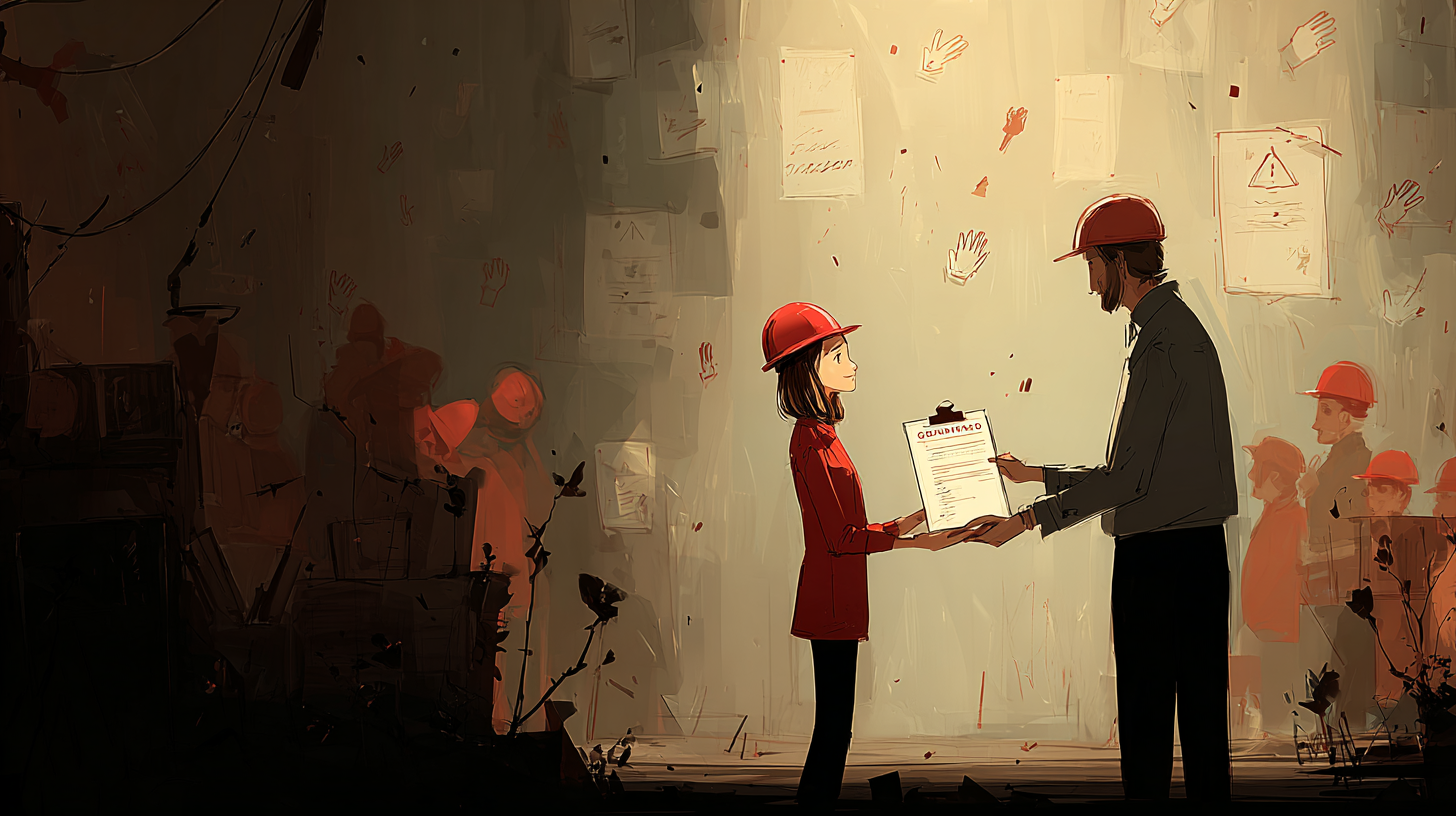A guideline is a simple rule or advice that helps you know what to do.
「guideline」は、何かをするときのやり方の目安やルールのこと。必ず守るルールではなく、助けとなるアドバイスのようなもの。
以下は英単語 “guideline” に関するストーリー型学習コンテンツです。まずは大枠の意味を理解して最後の文章で確認しましょう。
主な意味(main meaning)
| 品詞 | 意味 | 発音記号(IPA) | 英語例文 |
|---|---|---|---|
| 名詞 | 指針、ガイドライン(行動や判断の助けとなるルールや目安) | /ˈɡaɪdlaɪn/ | The teacher gave us clear guidelines for the project. |
語源(etymology)
guide(導く) + line(線)
から来ており、「進むべき方向を示す線」というイメージが語源です。つまり、行動の方向性を示す「目安」として使われます。
類義語(synonyms)
| 類義語 | 意味 | 英語例文 |
|---|---|---|
| instruction | 指示、使用方法 | Follow the instructions on the label. |
| rule | 規則、ルール | One of the rules is to turn off your phone. |
| principle | 原則、基本方針 | Honesty is an important principle in this company. |
| policy | 方針、運営ルール | The school has a strict policy on bullying. |
| protocol | 手順、公式な手続き | The safety protocol must be followed at all times. |
反義語(antonyms)
| 反義語 | 意味 | 英語例文 |
|---|---|---|
| disorder | 混乱、無秩序 | Without guidelines, the meeting ended in disorder. |
| chaos | 混乱、大混乱 | The lack of clear guidelines led to chaos in the office. |
コロケーション(collocations)
| コロケーション | 英語例文 |
|---|---|
| safety guidelines | All employees must follow the safety guidelines. |
| general guidelines | These are general guidelines for writing an essay. |
| follow the guidelines | Please follow the guidelines during the test. |
| provide guidelines | The doctor provided guidelines for a healthy diet. |
| clear guidelines | The manager gave clear guidelines for the task. |
2項表現(binomials)
| 2項表現 | 意味 | 英語例文 |
|---|---|---|
| rules and regulations | 規則と規定(厳格な決まり) | Every student must follow the school’s rules and regulations. |
| principles and values | 原則と価値観 | Honesty and respect are important principles and values in our company. |
| policies and procedures | 方針と手順 | The HR department explained the new policies and procedures. |
| rights and responsibilities | 権利と責任 | Citizens must understand their rights and responsibilities. |
| terms and conditions | 利用規約・条件 | Please read the terms and conditions before signing the contract. |
英語ストーリー(english story)
A New Job and the Guidelines
Tom had just started his new job at a manufacturing company. On his first day, his manager, Ms. Green, welcomed him warmly and said,
“Tom, before you begin, I want to explain our guidelines. These are not strict rules, but they are important if you want to do your work well.”
She handed him a booklet titled Safety Guidelines for New Employees. It explained how to use the machines safely. Tom noticed that the text was not too detailed. It gave general guidelines, such as “Always wear protective gloves” and “Check the machine before starting.”
Tom asked, “So, are these the same as instructions?”
Ms. Green smiled. “Good question. Instructions are step-by-step. For example, if you buy a microwave, you read the instructions to know exactly which button to press. But guidelines are broader. They help you understand what to do, but they don’t tell you every single action.”
Later, during the orientation, another manager spoke about the company’s policy on health and safety. He said, “Our policy is very clear: we want zero accidents. To support this policy, we provide guidelines like the ones you have.”
Tom thought about it carefully. He realized that a policy was a decision made by the company, while guidelines were the practical advice to follow that decision.
In the afternoon, Tom had training with Mr. Smith, the safety officer. Mr. Smith said, “In medical situations, people often use protocols. Protocols are official and must be followed exactly. But here in the factory, we usually follow guidelines, which give us flexibility.”
Tom nodded. He was beginning to understand the differences.
That evening, he reflected on the principles that Ms. Green had mentioned earlier. She said, “The most important principle in our company is honesty. If you make a mistake, please report it. That principle guides all of our actions.”
Tom now saw how everything fit together. The principle was the foundation, the policy was the company’s decision, the guidelines gave advice, the rules had to be obeyed, the instructions explained details, and the protocols were strict procedures.
On his second day, Tom was asked to operate a new machine. He opened the booklet again and found clear guidelines about safety. He carefully followed them. At the same time, his supervisor gave him specific instructions on which buttons to press.
By the end of the week, Tom felt more confident. He realized that the company’s system made sense: the guidelines supported the workers, not just by telling them what to do, but by showing them how to think and act responsibly.
和訳
新しい仕事とガイドライン
トムは製造会社で新しい仕事を始めたばかりでした。初日の朝、上司のグリーンさんが温かく迎えてくれて、こう言いました。
「トム、仕事を始める前に、会社の**guidelines(指針)を説明しておきます。これは厳しいrules(規則)**ではありませんが、仕事をうまく進めるために大切なものです。」
彼女は『新入社員のためのSafety Guidelines(安全指針)』と題された冊子を手渡しました。そこには機械を安全に使うための内容が書かれていました。詳しい操作説明ではなく、例えば「必ず防護手袋をつける」「機械を動かす前に確認する」といった**general guidelines(一般的な指針)**が載っていました。
トムは尋ねました。
「これは**instructions(手順)**と同じですか?」
グリーンさんは笑って答えました。
「いい質問ですね。instructionsは一歩ずつの具体的な方法を示します。たとえば電子レンジを買ったとき、どのボタンを押すか書いてあるのがinstructionsです。guidelinesはもっと広くて、大まかな行動の目安を示すものです。」
その後のオリエンテーションでは、別のマネージャーが会社の健康と安全に関するpolicy(方針)について話しました。
「私たちの方針はとても明確です。事故ゼロを目指します。その方針を支えるために、皆さんにguidelinesを**provide(提供)**しているのです。」
トムは考えました。policyは会社の決定であり、guidelinesはそれを実行するための助けになるものだと気づきました。
午後には安全管理者のスミスさんの研修がありました。スミスさんは言いました。
「医療の場ではprotocols(公式手順)を使います。これは絶対に守らなければなりません。でも、ここ工場では、柔軟に対応できるguidelinesを使っています。」
トムはうなずき、違いを理解し始めました。
その日の夕方、トムはグリーンさんが言っていた**principles(原則)**を思い返しました。
「私たちの会社で最も大切な原則は誠実さです。もし失敗したら、必ず報告してください。その原則がすべての行動を導いています。」
こうしてトムは、すべての関係を理解しました。principleは土台、policyは会社の決定、guidelinesは助言、rulesは必ず守る規則、instructionsは具体的手順、protocolsは厳格な手続き。
二日目、トムは新しい機械を操作することになりました。再び冊子を開くと、**clear guidelines(明確な指針)が載っていました。彼はそれを注意深く守り、同時に上司からは細かいinstructions(手順)**を受けました。
一週間が終わるころには、トムは自信を持てるようになっていました。彼は、この会社のシステムがよくできていると感じました。guidelinesはただ「やるべきこと」を示すだけではなく、「どう考え、どう責任を持って行動するか」を教えてくれるものだったのです。
Q&A
- Qguideline と instruction の違いは?
- A
「instruction」は「具体的な使い方や手順」を意味します。何かを操作する時に使います。
「guideline」は「大まかな方針や助けになるルール」を示します。
- Qguideline と rule の違いは?
- A
「rule」は守らなければならない「決まり」で、違反すると罰があることもあります。
「guideline」はあくまで目安であり、柔軟に対応できるものです。
- Qguideline と principle の違いは?
- A
「principle」は道徳や考え方の「基本方針」。行動の価値観を示します。
「guideline」は実際にどう行動すればよいかの「具体的な目安」です。
- Qguideline と policy の違いは?
- A
「policy」は組織が正式に決めた「方針」で、上からの決定に近いものです。
「guideline」はその方針に沿って行動するための「助け」となる目安です。
- Qguideline と protocol の違いは?
- A
「protocol」は「正式な手順」や「規定された方法」で、特に医療や技術分野でよく使います。
「guideline」はそこまで厳密でなく、柔らかい「行動の方向性」のことです。
- Qsafety guidelines と safety rules の違いは?
- A
「safety rules」は絶対に守るべき「安全の決まり」。
「safety guidelines」は「安全のためのおすすめ行動」で、やや柔らかい表現です。
- Qgeneral guidelines と general rules の違いは?
- A
「general rules」は普遍的で固定された決まり。
「general guidelines」は状況に応じて応用できる柔軟なアドバイス。
- Qfollow the guidelines と follow the instructions の違いは?
- A
「guidelinesをfollowする」ときは「大まかな目安に従う」感覚。
「instructionsをfollowする」ときは「細かい手順をそのまま守る」感覚です。
- Qprovide guidelines と provide instructions の違いは?
- A
「provide guidelines」は方向性やおすすめ行動を示すこと。
「provide instructions」は細かい操作ややり方を教えることです。
- Qclear guidelines と strict rules の違いは?
- A
「clear guidelines」は「わかりやすい助言や目安」を意味します。
「strict rules」は「厳しく守らせる規則」を意味します。



コメント